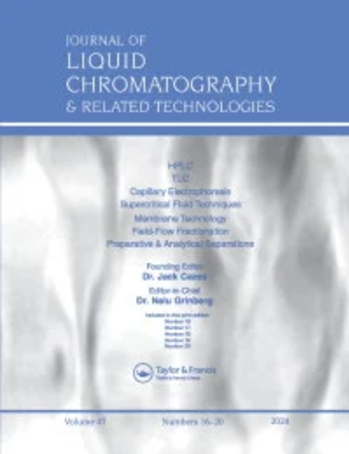高效可靠的CE-SDS分离由高速涡轮增压CE-SDS®墨盒
IF 1.2
4区 化学
Q4 BIOCHEMICAL RESEARCH METHODS
Journal of Liquid Chromatography & Related Technologies
Pub Date : 2023-10-18
DOI:10.1080/10826076.2023.2269233
引用次数: 0
摘要
毛细管电泳-十二烷基硫酸钠(CE-SDS)是一种现代形式的SDS-PAGE,利用毛细管电泳按大小分离蛋白质。该技术是基于毛细管中网状结构的筛分作用。在这项研究中,我们比较了Maurice Turbo CE- sds墨盒™和Maurice CE- sds PLUS墨盒,两者都是为Maurice CE系统开发的。Turbo墨盒被发现比PLUS墨盒快4-5倍,同时保持相似的分离效率。定量限为0.1 mg/mL,信噪比(S/N)为18.55。在0.1 ~ 4 mg/mL范围内线性良好,相关系数(R2)≥0.99。在长时间的测量中,分离效率保持不变,混合物中蛋白质的相对迁移时间在1000次注射后保持稳定。这些结果表明,Turbo CE-SDS试剂盒是一种非常有用的工具,可以快速有效地分析蛋白质(混合物)。较短的分析时间可以通过减少分析所需的时间和耗材来节省大量资源,同时高LOQ和线性确保了该方法的灵敏度和准确性。关键词:cece - sds比较电泳验证披露声明作者声明在本研究中没有完全的利益。srm进行了实验,撰写了手稿,并设计了研究。UB参与了研究设计,并部分监督了该项目。LM按照指示进行重复实验。SD部分监督了该项目。HW监督了整个项目并修改了稿件。所有作者都阅读并批准了最终的手稿。数据和材料的可用性本研究过程中产生或分析的所有相关数据都包含在这篇发表的文章及其附加文件中。在当前研究中使用和/或分析的缺失数据集可根据通讯作者的合理要求提供。竞争利益sudo Burger和Susanne Doerks是ProteinSimple(生物技术品牌)的员工。发表同意不适用。利益声明udo Burger和Susanne Doerks是生物技术公司的员工。对参与者的伦理批准和同意不适用。本研究由Protein Simple (Bio-Techne品牌)提供材料支持。本文章由计算机程序翻译,如有差异,请以英文原文为准。
Efficient and reliable CE-SDS separations by the high-speed turbo CE-SDS ® cartridge
AbstractCapillary electrophoresis-sodium dodecyl sulfate (CE-SDS) is a modern form of SDS-PAGE that uses capillary electrophoresis to separate proteins by size. The technique is based on the sieving effect of net-like structures in the capillary. In this study, we compared the Maurice Turbo CE-SDS Cartridge™ with the established Maurice CE-SDS PLUS Cartridge, both developed for the Maurice CE system. The Turbo cartridge was found to be up to 4–5 times faster than the PLUS cartridge, while maintaining similar separation efficiency. The limit of quantitation (LOQ) for the Turbo cartridge was estimated to be 0.1 mg/mL with a signal-to-noise ratio (S/N) of 18.55. The linearity of the cartridge was verified in the range of 0.1–4 mg/mL, with correlation coefficient (R2) values of at least 0.99. The separation efficiency remained constant over long series of measurements, and the relative migration time of proteins in a mixture remained stable over 1,000 injections. These results demonstrate that the Turbo CE-SDS Cartridge is a very useful tool for fast and efficient analysis of protein (mixtures). The shorter analysis time can save significant resources by reducing the time and consumables required for analysis, while the high LOQ and linearity ensure that the method is sensitive and accurate.Keywords: CECE-SDScomparisongel electrophoresisvalidation Disclosure StatementThe authors declare there is no Complete of Interest at this study.AcknowledgmentsNot applicableAuthors’ contributionsRM performed the experiments, wrote the manuscript, and designed the study. UB participated in study design and partly supervised the project. LM carried out repetitive experiments as instructed. SD partly supervised the project. HW supervised the entire project and revised the manuscript. All authors read and approved the final manuscript.Availability of data and materialsAll relevant data generated or analyzed during this study are included in this published article and its additional file. The missing datasets used and/or analyzed during the current study are available from the corresponding author upon reasonable request.Competing interestsUdo Burger and Susanne Doerks are employes of ProteinSimple (a Bio-Techne Brand).Consent for publicationNot applicable.Declaration of interestUdo Burger and Susanne Doerks are employees of Bio-Techne.Ethics approval and consent to participateNot applicable.Additional informationFundingThis work was supported by Protein Simple (a Brand of Bio-Techne) with materials.
求助全文
通过发布文献求助,成功后即可免费获取论文全文。
去求助
来源期刊
CiteScore
2.80
自引率
0.00%
发文量
29
审稿时长
4.9 months
期刊介绍:
The Journal of Liquid Chromatography & Related Technologies is an internationally acclaimed forum for fast publication of critical, peer reviewed manuscripts dealing with analytical, preparative and process scale liquid chromatography and all of its related technologies, including TLC, capillary electrophoresis, capillary electrochromatography, supercritical fluid chromatography and extraction, field-flow technologies, affinity, and much more. New separation methodologies are added when they are developed. Papers dealing with research and development results, as well as critical reviews of important technologies, are published in the Journal.

 求助内容:
求助内容: 应助结果提醒方式:
应助结果提醒方式:


